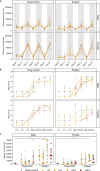Refining pain management in mice by comparing multimodal analgesia and NSAID monotherapy for neurosurgical procedures
- PMID: 39134625
- PMCID: PMC11319454
- DOI: 10.1038/s41598-024-69075-2
Refining pain management in mice by comparing multimodal analgesia and NSAID monotherapy for neurosurgical procedures
Abstract
While neurosurgical interventions are frequently used in laboratory mice, refinement efforts to optimize analgesic management based on multimodal approaches appear to be rather limited. Therefore, we compared the efficacy and tolerability of combinations of the non-steroidal anti-inflammatory drug carprofen, a sustained-release formulation of the opioid buprenorphine, and the local anesthetic bupivacaine with carprofen monotherapy. Female and male C57BL/6J mice were subjected to isoflurane anesthesia and an intracranial electrode implant procedure. Given the multidimensional nature of postsurgical pain and distress, various physiological, behavioral, and biochemical parameters were applied for their assessment. The analysis revealed alterations in Neuro scores, home cage locomotion, body weight, nest building, mouse grimace scales, and fecal corticosterone metabolites. A composite measure scheme allowed the allocation of individual mice to severity classes. The comparison between groups failed to indicate the superiority of multimodal regimens over high-dose NSAID monotherapy. In conclusion, our findings confirmed the informative value of various parameters for assessment of pain and distress following neurosurgical procedures in mice. While all drug regimens were well tolerated in control mice, our data suggest that the total drug load should be carefully considered for perioperative management. Future studies would be of interest to assess potential synergies of drug combinations with lower doses of carprofen.
Keywords: 3R; Craniotomy; Multimodal analgesia; Postsurgical pain; Severity assessment.
© 2024. The Author(s).
Conflict of interest statement
The authors declare no competing interests.
Figures







Similar articles
-
Evolving Role of Local Anesthetics in Managing Postsurgical Analgesia.Clin Ther. 2015 Jun 1;37(6):1354-71. doi: 10.1016/j.clinthera.2015.03.017. Epub 2015 Apr 10. Clin Ther. 2015. PMID: 25866297 Review.
-
Evaluation of Pain Assessment Techniques and Analgesia Efficacy in a Female Guinea Pig (Cavia porcellus) Model of Surgical Pain.J Am Assoc Lab Anim Sci. 2017 Jul 1;56(4):425-435. J Am Assoc Lab Anim Sci. 2017. PMID: 28724492 Free PMC article.
-
The analgesic effects of buprenorphine (Vetergesic or Simbadol) in combination with carprofen in dogs undergoing ovariohysterectomy: a randomized, blinded, clinical trial.BMC Vet Res. 2018 Oct 5;14(1):304. doi: 10.1186/s12917-018-1628-4. BMC Vet Res. 2018. PMID: 30290820 Free PMC article. Clinical Trial.
-
Using Cageside Measures to Evaluate Analgesic Efficacy in Mice (Mus musculus) after Surgery.J Am Assoc Lab Anim Sci. 2018 Mar 1;57(2):186-201. J Am Assoc Lab Anim Sci. 2018. PMID: 29555008 Free PMC article.
-
Perioperative pain management in the neurosurgical patient.Anesthesiol Clin. 2012 Jun;30(2):347-67. doi: 10.1016/j.anclin.2012.05.004. Epub 2012 Jun 23. Anesthesiol Clin. 2012. PMID: 22901614 Review.
Cited by
-
Testing perioperative meloxicam analgesia to enhance welfare while preserving model validity in an inflammation-induced seizure model.Sci Rep. 2024 Dec 19;14(1):30563. doi: 10.1038/s41598-024-81925-7. Sci Rep. 2024. PMID: 39702430 Free PMC article.
-
Subcutaneous and orally self-administered high-dose carprofen shows favorable pharmacokinetic and tolerability profiles in male and female C57BL/6J mice.Front Vet Sci. 2024 Sep 20;11:1430726. doi: 10.3389/fvets.2024.1430726. eCollection 2024. Front Vet Sci. 2024. PMID: 39376917 Free PMC article.
-
A Retrospective Report of Carprofen Administration as Post-Operative Analgesia Reveals Negative Effects of Recommended Doses.Animals (Basel). 2024 Nov 4;14(21):3157. doi: 10.3390/ani14213157. Animals (Basel). 2024. PMID: 39518880 Free PMC article.
References
Publication types
MeSH terms
Substances
Grants and funding
LinkOut - more resources
Full Text Sources
Medical

